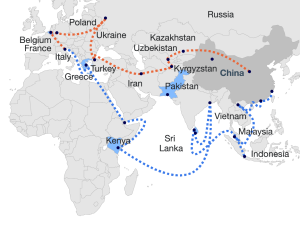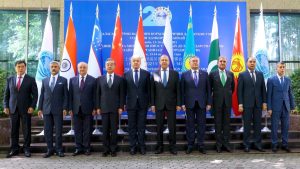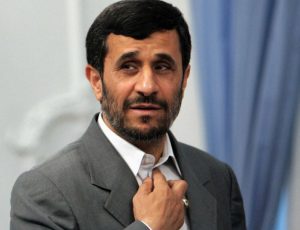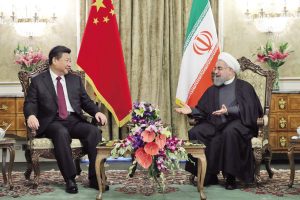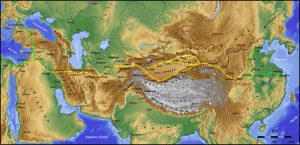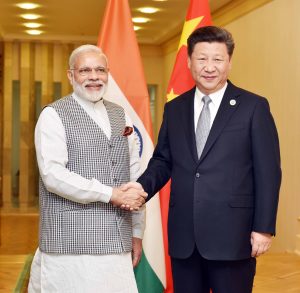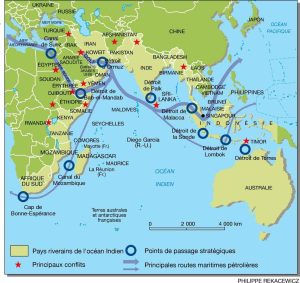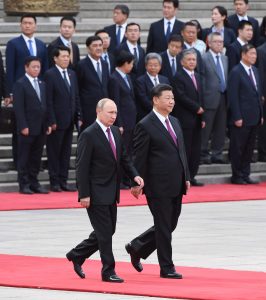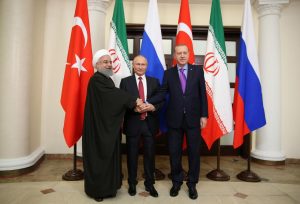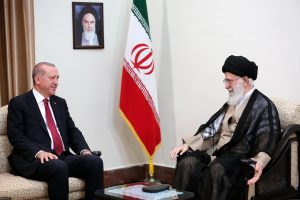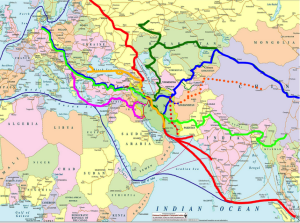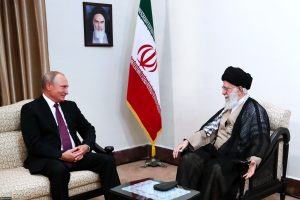by Glauco D’Agostino
The crisis in Ukraine looks to have diverted the world’s attention away from Eastern geopolitical events. Yet, the East shapes the most remarkable changes in the global order. Following expulsion from Afghanistan, the White House’s most significant concern is the growing importance of the Shanghai Cooperation Organisation, given the Chinese-driven regional aggregation now includes Russia, Iran, and, above all, India. Washington voices opposition to the Chinese commercial ability, the Road and Belt Initiative and Russia’s imperial surge. Meanwhile, it fails to overcome even the vetoes at a resumption of the JCPOA negotiation with Iran and loses the solidarity from India involved in the Quadrilateral Security Dialogue in Asia. Perhaps, the conflict in Ukraine has disclosed US isolation, which, in perspective, one could glimpse into the tiresome relationship with the Europe allied partners since the White House requires them to break off energy supplies from Moscow and veto the start of the Silk Road infrastructure projects.
This analysis by Glauco D’Agostino, focused on the growing but not always easy relations among Tehrān, Beijing and Moscow, predates the Ukrainian crisis and was first published last February in “Geopolitica. Revistă de Geografie Politică, Geopolitică şi Geostrategie,” Anul XX, nr. 92-93 (1 / 2022) “INFRASTRUCTURI CRITICE EMERGENTE – RISCURI GEOPOLITICE.”
Abstract:
If Tehrān today looks at Beijing and Moscow, the West can only regret itself short-sightedness in foreign policy. Iran’s admission to the SCO breaks international isolation due to the US sanctions. The new Raisi’s leadership and even the so-called “moderates” have not ignored the problem, which risks bringing the nation to its knees. There is no doubt the American unilateral JCPOA withdrawal and its muscular use of force in the Middle East have prompted Iran to accentuate its geopolitical vision towards the East already there.
The Islamic Republic has sure developed intense relationships with China and Russia. Tehrān looks with sizeable openness to the Belt and Road Initiative, and trustfully at the strategic alliance with Moscow in the Middle East, even though problems do not lack, especially in the Caucasian area. In addition, Beijing and Moscow are JCPOA’s partners and may play an important role in regaining nuclear talks. The mediation capacity of Chinese and Russian leadership centres on their flexibility. All that is also part of the US-China harsh dispute, which has its explicit exhibition in the Gulf and Indo-Pacific geostrategic theatres. India, Central Asia, Caucasus, Caspian, Middle East, including Israel are areas where China will be again a power mediating opposing interests. Iran, as well, will have to bear in mind that the Chinese non-interference policy excludes it can align with the logic of the blocks, also considering its good attitude toward Saudi Arabia, Emirates and Israel.
The relations between the Islamic Republic and the Russian Federation are ambivalent and mainly concern the transport corridors crossing the Caucasus and Caspian. Iran may have both interests in keeping its axis with Armenia and Russia on the North-South Corridor and opening to Turkey and Azerbaijan on geostrategic grounds. Mutual distrust arises precisely from the uncertainty of the geopolitical framework and the mutability of alliances, which, outside the past ideological, are flexible and built on the 21st-century far-sighted parameters.
Keywords: Iran, China, Russia, SCO, Belt and Road Initiative, JCPOA, sanctions, transport corridors, non-interference, USA-China dispute, logic of the blocks, Indo-Pacific, Central Asia, Middle East, Caucasus, Caspian.
***
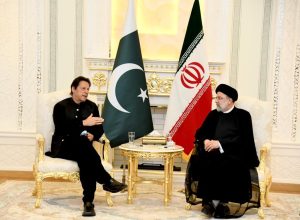
Iranian President Ebrāhīm Raisi with then-Prime Minister of Pakistan Imran Khan at the Dushanbe’s SCO Summit, September 16th, 2021
Access to the SCO and the US sanctions
On September 17th, the Shanghai Cooperation Organisation (SCO), when meeting in the Tajik capital Dushanbe, has given consent to the Islamic Republic of Iran’s entry as a permanent member. Now, a process for full membership will follow as for Pakistan and India, members since 2017.
The decision rewards the perseverance of Iran (which has been an observer state since 2005) in pursuing its goal through a gradual diplomatic approach that has borne fruits. Since 2007, yet, Tehrān by President Maḥmūd Aḥmadinejād had been taking part in top-level multilateral meetings between the six countries (China, Russia, Kazakhstan, Kyrgyzstan, Tajikistan and Uzbekistan) in 2001 founded this political, economic and security regional aggregation.[1] In 2008, the first application for admission failed on the opposition of some states due to UN sanctions on nuclear power. The same occurred the following year at Tajikistan’s hands. The acceleration came when, in March 2020, Beijing and Tehrān announced a US$-400-billion agreement in Chinese investments in Iran over the next 25 years: it was the first visible opening towards Tehrān’s acceptance into the SCO.[2] Exactly one year later, that agreement formalised as a global strategic partnership with particular regard to the energy, infrastructure and technology sectors.[3]
The SCO, which replaces the 1996 Treaty on Deepening Military Trust in Border Regions (Shanghai Group), brings together eight countries that today represent 40% of the world population, 20% of the global GDP and 60% of the Euro-Asian continental area.[4] Beijing sees it as an instrument of multilateralism and an expression of the non-interference political will it employs in international politics in the world.[5]
The new Iranian President Ebrāhīm Raisi seems to think so. Addressing the SCO leaders, according to The Jerusalem Post reports, he said: “The world has entered a new era. Hegemony and unilateralism have failed … The international balance from now on leans towards multilateralism and the redistribution of powers towards independent countries. Unilateral sanctions don’t uniquely target one country. It has become evident that, in recent years, they affect more the independent countries, especially SCO members.”
On the Iranian side, the issue seems to revolve around the international isolation Tehrān has been forced to by the US sanctions imposed by Trump and confirmed by Biden. Admission to the SCO breaks this isolation, giving it new strength to withstand Western pressure. Undoubtedly, the new Raisi’s leadership and the so-called “hardliners” eased the embrace with Beijing. But even the so-called “moderates” could not in the past and cannot today ignore the problem of isolation and “unlawful and inhumane”[6] sanctions, which risk bringing the nation to its knees. The US foreign policy fickleness has caused bewilderment among the Iranians, has embarrassed the Ruhani Presidency, and made the continuing US squeeze on Iran appear like a dangerous noose around its neck. After all, President Ruhani, which signed and managed the comprehensive strategic partnership with Beijing, has shown the inevitability of this decision, especially after General Sulaimānī’s meaningless assassination.
To what extent is this Iranian policy process merely a result of its anger toward Washington or, instead, a systematic strategy of alliance with the Asian giants, China and Russia? Probably, neither of these extreme hypotheses. But there is no doubt the American unilateral JCPOA withdrawal and its muscular use of force in the Middle East have prompted Tehrān to accentuate its geopolitical vision towards the East already there. On the other hand, the launch of the ten-year agreement on the trade expansion between Iran and China dates to 2016, during the Tehrān Xi Jinping-Ruhani meeting.[7]
The Islamic Republic has sure developed intense relationships with China and Russia, which, as well, are affected by US sanctions. As a matter of priority, Tehrān looks with sizeable openness to the Belt and Road Initiative and the resulting billionaire contracts that will allow it to adapt its troubled infrastructural and commercial networks. And it looks with confidence at the strategic alliance with Moscow in the Middle East cemented by Baššar al-Asad’s joint defence, even though problems do not lack, especially in the Caucasian area. In addition, Beijing and Moscow are JCPOA’s partners and may play an important role in regaining nuclear talks that already started on November 29th. Here a picture of Iran-China and Iran-Russia bilateral problems is outlined in the more complex sphere of geopolitical games.
The Silk Road and “Marine Security Belt”
The Belt and Road Initiative, announced in September 2013, has now an intercontinental scope as it is part of the issue of controlling commercial traffic between Asia, Europe and Africa, both by land and sea. In the former case, the routes involve Central Asia, Iran and the Middle East, to the Persian Gulf and the Mediterranean; in the latter, the Pacific and Indian Oceans, from Hawaii, Japan, the Philippines, Indonesia, Indochina, the Indian sub-continent, to the Arabian Peninsula, Europe and East Africa, and embroiling the bottlenecks of Malacca, Hormuz, Bāb al-Mandeb and Suez Straits. Therefore, one can understand the Chinese interest in involving Iran as a primary strategic partner in the western initiative segment. Iran has both continental and maritime nature, such as welcoming traffic from Central Asia and the Indo-Pacific to convey it to the Caucasus, the Mediterranean, the Sahel and the Horn of Africa: a proper service transport hub featured as an energy-producing country, worthwhile to China, as well, for propelling its industry and trade expansion.
In September, Javad Owji, the Raisi government’s new oil Minister, said plans over the next 4-8 years were underway to attract US$ 145 billion from Iranian and foreign investors (likely Chinese, Russian and Indian). The budget includes the first share of the global strategic partnership signed with China, which for the next 25 years will allocate US$ 280 billion to Iran for the development of the oil, gas and petrochemical sectors; and the remaining 120 to upgrade the transport and production infrastructures. Displaying Iran’s interest in the partnership, the Minister added: “Iran is ready to cooperate fully with Chinese companies to develop oil industry projects in the upstream and downstream sectors…We expect the administration to have many partnerships and agreements between Iran and China” (Watkins, 2021).
For its part, China as well looks to the Islamic Republic with confidence while taking into account its following characteristics:
- The non-hostile propensity towards Beijing’s territorial and geopolitical interests;
- A policy of bulwark against Washington’s geopolitical intrusiveness in the Middle East;
- The concern in seeking alliances in the area to counter the US heavy pressure in economic and military terms;
- Its role as a regional player able of keeping the Middle Eastern disintegrating impulses at bay;
- The stability (and related reliability) of the institutions, which for over 40 years have been firmly standing, despite external aggressions, wars, regime-change threats, boycotts and sanctions;
- The Shiite nature of its religious and political foundations, which has no appeal to the Muslim internal and border populations of the People’s Republic.
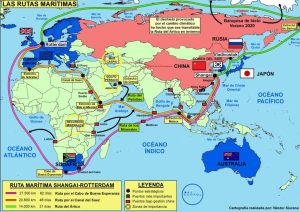
Main maritime routes between Shànghăi and Rotterdam (cartography by Néstor Siurana; source: Geopol 21)
All that is also part of the US-China harsh dispute, which has its explicit exhibition in the Gulf and Indo-Pacific geostrategic theatres, hence the previous reflections raised on the Belt and Road Initiative‘s importance.
In December 2019, the Iran-China-Russia “Marine Security Belt” exercise in the Sea of Oman and the Gulf challenged the American hegemonic power for the first time, proving the inconsistency of its alleged undisputed rule over the seas. Considering that about 30% of the world’s crude oil passes through the Strait of Hormuz, which gives access to the Gulf, the concordance between the three countries not bound by any strategic military pact sent a message of firm opposition to the American policy of sanctions.[8] Jonathan Eyal, Associate Director at the British defence and security think tank Royal United Services Institute, went so far as to say: “The strategic message is that these are the countries shaping events in the Middle East.”[9] Those exercises recur annually, and even a few months ago, last February, military ships repeated them in the northern Indian Ocean, with the alleged participation of Indian ships confirmed by the Chief of the Iranian Navy and denied by the Indian Navy.[10]
Indo-Iranian relations and the Indo-Pacific
Everything looks to turn around India’s role. A year ago, the international media seemed to credit an alliance between Russia, China, Pakistan, Iran and Turkey, a coalition keeping Turkey, a NATO country, inside, and India, an SCO country, outside. Iranian Ambassador to Pakistan Seyyed Moḥammad-‘Alī Ḥosseini raised the hypothesis in a lecture at the Islamabad Strategic Studies Institute: “Countries like Iran, Pakistan, Turkey, Russia and China have the potential to form a new alliance for better future of the region,” he said, alluding to the due response to the isolationist policy of Indian Prime Minister Modi related to a necessary continental integration.[11] And he continued underlining the economic-commercial harmony between Iran and Pakistan and the need for cooperation between Muslim countries: “ECO provides an appropriate opportunity for Iran-Pakistan to coordinate their policies.” The reference to the ECO (Economic Cooperation Organization)[12] specifically called into question Turkey and its involvement in the common Islamic cause, pointing out, on the other hand, the ineffectiveness of the Organisation of Islamic Cooperation for Umma purposes.[13]
Washington is not idle, of course, and, among the many counter-initiatives of Chinese containment, flaunts the QUAD. The Quadrilateral Security Dialogue between the United States, Japan, India and Australia has the ideological intention of creating an “Asian Arc of Democracy.” Japanese Prime Minister Shinzō Abe, the Dialogue pioneer in 2007, called it so while masking the goal to master Indo-Pacific trade and forging the “Indo-Pacific” portmanteau neologism to motivate the alliance’s geographical breadth in an anti-Chinese function.
First of all, as mentioned above, since 2017, India has been part of the Russo-Chinese-inspired SCO and, if it has not broken the Quadrilateral Dialogue, at least it has weakened it considerably. Moreover, that very dialogue helped militarise the area in support of the current geopolitical order presumably China threatens (Fowdy, 2021). There is evidence of it: for instance, the annual Exercise Malabar naval activity (with the intervention of aircraft carriers and operations of maritime interdiction and anti-aircraft warfare); and its involved area, since an edition took place in the Gulf.
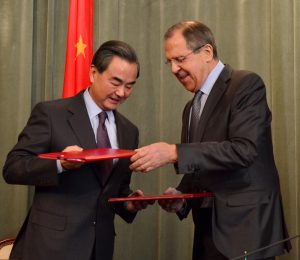
Russian Foreign Minister Sergej Lavrov with the Chinese State Councilor and Minister of Foreign Affairs Wáng Yì, Moscow, March 11th, 2016
In short, it is a Cold War air (Spyer, 2021) magnified by last September news about the trilateral AUKUS pact between Australia, the UK and the US to equip Australia with nuclear-powered submarines. In July, on the sideline of the International Conference “Central and South Asia: Regional Connectivity. Challenges and Opportunities” held in Taškent, the Russian Foreign Minister Sergej Lavrov, after a meeting with the Chinese State Councilor and Minister of Foreign Affairs Wáng Yì, stated that “the existing bilateral ties surpass such a form of interstate interaction as military-political alliances of the Cold War era.”[14] Lavrov’s remarks called on the White House’s aptitude to establish military alliances with direct politico-ideological implications to an international order for American hegemony. It often results in heavy interference in the internal politics of the allied countries.
The Central Asian issue and Sino-Russian-Iranian relations
Though Moscow-Beijing Axis is not as strong as their protagonists show it, the alliance indeed proves the required flexibility to allow a mutual foreign policy autonomy, except for the obvious limitations of not taking too much advantage in the freedom of action. We can see it in the not complete Russian accord on China’s strategic expansion policy to the Pacific, former Soviet Asian countries or Pakistan, as well as the Chinese concern about Russian diplomatic activism in Southeast Asia or military cooperation with Delhī.[15] India once more! But the mediation capacity of the Chinese and Russian leaderships, ready to settle any divergences in a medium-long term strategic planning, assesses on this ground. It was so with the SCO entry of India and Pakistan, and now Iran’s. It likely will be the case of the Taliban’s Afghanistan layout.
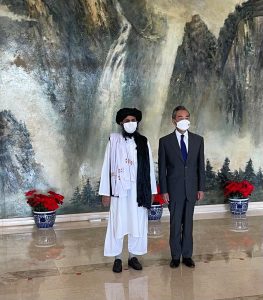
Mullāh Abdul Ghani Baradar, Acting First Deputy Prime Minister of Afghanistan, with Wáng Yì, Chinese State Councilor and Minister of Foreign Affairs (July 28th, 2021)
When Jason Campbell, the former Director for Afghanistan in the US Office of Defense for Policy, says that “the geostrategic effect could be profound … China, Russia, and even Iran could benefit from the new political order in Kabul,”[16] he speaks from an American perspective, as is right given his role and nationality. When adding the remarks of Iranian President Raisi that “America’s military defeat must become an opportunity to restore life, security, and durable peace in Afghanistan,”[17] the Washington alert becomes even more understandable. Yet, from another viewpoint, those benefits and opportunities not only cover the geopolitical advantage driving to China, Russia and Iran, but the prospects of opening up to Central Asian countries. The former Soviet republics of the area, and Afghanistan itself, all countries with no access to the sea, find an outlet only towards China, Russia and Iran; therefore, they, as well, want to share the development process Belt and Road Initiative and SCO allow. The price to pay in terms of dependence will not be heavier than the one American political-war attitude imposed.
Tehrān-born Alex Vatanka, Director of the Iran Program at the Washington-based Middle East Institute, recalls, for example, Kazakhstan’s push to establish commercial and infrastructural collaboration relationships with Iran as an outlet to world markets and a transit for goods from China: the 925-km Kazakhstan-Turkmenistan-Iran rail line opened in December 2014 served in February 2016 for the transit of the first cargo from China to Iran. Iranian availability also allowed Kazakhstan to play a mediating role during the Almaty nuclear talks. It is an example making clear how the collaboration between four countries in the area involved in an economic process is fruitful for all parties’ interests.
Conversely, Vatanka himself points out some problem arrangements of interests among SCO members and beyond. This time, the example concerns the Iranian port of Chābahār and the Pakistani port of Gwadar, both on the Indian Ocean shores at a distance of just 170 km. Despite the Iranian notes aimed at a reciprocal complementarity (Iqbal, 2020), there are many obstacles to this happening. The Port of Chābahār, a privileged hub for Afghanistan and Central Asia access and meant to complement Bandar-e ‘Abbās congested seaport, has since 2016 enjoyed significant investments by Delhī, which favour this infrastructure as compared to the Port of the former Omani possession of Gwadar due to evident contrasts with its rival Pakistan.[18] China has instead invested right in the latter as part of the Belt and Road Initiative programs, including Iran and its port infrastructures. Thus, China will be once again a power mediating opposing interests.
Given an Asian geopolitical framework so compounded, the question is how much Beijing will allow to involve itself in Middle Eastern disputes. For now, the Chinese non-interference policy excludes it can align with the logic of the blocks. As a closer relationship with Iran is emerging today, we must note that China is the largest buyer of Saudi oil and keeps excellent trade relations with the Emirates and Israel, all opponents to Iranian politics. It means Beijing has all the credentials to offer itself as a reliable mediator. And it would enable it to have a say in the Yemeni disputes between Saudis and Ḥūthi Shiites, with an eye to the stability of the Strait of Bāb al-Mandeb and Djibuti, in the area of which it has a naval base in competition with the USA and Japan ones.
Iran and the challenging Caucasian relations
As regards Tehrān’s relationship with Moscow, given the accord in Syria on its western front, on the north, the relations between the Islamic Republic and the Russian Federation are ambivalent and mainly concern the Caucasus and Caspian. We reiterate once again the importance of Iran as a crossroad of commercial traffic and a potential transport hub. Iran is an integral part or at least interested in other partially ongoing projects:
-
The 7,200-km-long multimode International North-South Transport Corridor, which in the area involves the grounds of Iran, Azerbaijan and Russia and plans to convey merchandise and goods from India and Central Asia to Europe,[19] while avoiding the transport difficulties and long times caused by the Straits of Bāb al-Mandeb and Suez transit. While Russia, Iran and India are its promoters, some Central Asian countries with Turkey and Armenia, Ukraine and Belarus, Syria and Oman are today members of the related agreement and witness their interest in developing that Corridor;
- The Middle Corridor Trans-Caspian International Transport Route, starting from Southeast Asia and China through Kazakhstan, the Caspian Sea, Azerbaijan, Georgia and further to Turkey or Poland via the Black Sea. The relative logistics association was born in 2016 on the initiative of Kazakhstan, Azerbaijan and Georgia bodies and organisations of transport;[20]
- The China-Central Asia-West Asia Economic Corridor, linking China to the Central-Asian countries, Iran, and Turkey.[21] The Corridor is part of the Belt and Road Initiative, but Beijing has not yet invested in upgrading the related Iranian infrastructures.
It is clear the Iran-Russia mutual transport and commercial relations feel the effects of the structures of two interconnected sensitive areas: the Caucasus and the Caspian.
The end of the Azerbaijani-Armenian conflict over Nagorno-Karabakh recognised the Russian mediation by Putin, the architect of the November 2020 armistice. One point of the agreement concerns the restoration of transport links, particularly the connections linking the Azerbaijani Autonomous Republic of Naxçıvan and the rest of the national territory, including the Syunik southern Armenia province. Erevan acknowledges the transport opening favours the Armenian connections with Iran and Russia, its direct or confidential supporters for decades. Nevertheless, Bakı’s proposal for a transport corridor to its allied Turkey under the last June Şuşa Declaration met with the refusal of Armenian Premier Pashinyan, inasmuch it assumed a geopolitical “logic of corridor”[22] moreover set on the Southern Gas Corridor. His Ministry of Foreign Affairs also reiterated this position, accusing Turkey, Iran and Azerbaijan of “making public agreements against the territorial integrity and sovereignty of the Republic of Armenia.”[23] Then, last October 15th, Pashinyan agreed to build a railway through the Syunik area bordering Iran.[24] So, how do you explain the Armenian attack on Iran in the Armenian-Azerbaijani dispute?
Russia and Iran, as mentioned above, belong to the International North-South Transport Corridor; Azerbaijan and Turkey lie on a Trans-Caspian Middle Corridor routes, but Iran and Turkey have common interests in the future China-Central Asia-West Asia Economic Corridor. To overcome the conflicts in the area, President Erdoğan last year proposed the “Six-way Platform”, a clearinghouse made up of Russia, Turkey, Azerbaijan, Iran, Georgia and Armenia.[25] The corridor planning rationale barely only frames the short-term needs of commercial policy. On the other hand, mutual distrust arises precisely from the uncertainty of the geopolitical framework and the mutability of alliances, which, outside the past ideological, are flexible and built on the 21st-century far-sighted parameters.[26]
In the case in question, Iran may have both interests in keeping its axis with Armenia and Russia on the North-South Corridor and opening to Turkey and Azerbaijan on geostrategic grounds. One should also remember its historical relationship to the Azerbaijani land (which had been part of the Persian Empire until 1813) and the Azeri people (in Azerbaijan, Shiites are 90%,[27] and in Iran, 18-30% of people is ethnically Azeri[28]). However, the recent misunderstandings between Bakı and Tehrān determined last October by Iranian military exercises near the border with Azerbaijan (followed by resulting joint Turkish-Azerbaijani-Pakistani exercises) do not go in the direction of detente. And the mocking words of Turkish President Erdoğan on October 21st aggravate the situation: “I do not expect the recent events to result in a military confrontation between Iran and Azerbaijan, because, on the one side, Azerbaijan has relations with Israel and on the other side, Iran take into account the sizeable Azeri population inside.”[29]
The Caspian, a shared but disharmonious sea
The Azerbaijani-Iranian clash, under the shadow of the looming attitude of Turkey (a NATO country), calls as well forth the thorny relationship between the countries on the Caspian shores. In 2019, Iran and Russia renewed the Caspian military cooperation,[30] framed in the 2015 Agreement.[31] But their stances on the inland sea are not perfectly aligned, and there is no lack of controversies. Until the USSR’s fall, Moscow and Tehrān shared the Caspian management. When Kazakhstan, Azerbaijan and Turkmenistan gained independence, the three Asian countries had claimed their right to share seabed, resources management and shipping with the other coastal countries. Whereas the Russian Federation was in difficulty with the quotas to be recognised (also after the obligations from the Alma-Ata Declaration[32] that established the Commonwealth of Independent States), Moscow began bilateral negotiations with the involved countries (Tafazzoli, 2021).
Following multilateral attempts and the Aşgabat, Tehrān, Bakı and Astrakhan presidential summits, in 2018, the Convention on the Legal Status of the Caspian Sea (known as Aktau Agreement after the Kazakh city on Caspian) set the legal terms of the dispute in the framework of international law.[33] Iran and Russia earned two key results:
- The lack of international waters in the Caspian (divided entirely between the coastal countries), which prevented the presence of military fleets from Western countries and allowed, on the other hand, the predominant Russian and Iranian ones;[34]
- The veto power on submarine pipelines to transport gas and oil from Kazakhstan and Turkmenistan to Azerbaijan and Europe.
In Tehrān, however, there was no lack of controversies about the alleged undue grants of sea quotas the Ruhani Presidency allowed to Moscow and the discontent over the inefficacy of military coordination with Russia related to the Azerbaijani navy enhancement with Israel and Turkey concurrence (Tafazzoli, 2021). It coupled with other misconducts the Iranians reportedly attribute to the Russians on the nuclear negotiations and the management of the 2020 Nagorno-Karabakh armistice agenda. It is now up to President Raisi to dispel these doubts and re-establish an axis that has suffered considerably in recent years.
Final remarks
If Tehrān today looks at Beijing and Moscow, the West can only regret itself short-sightedness in foreign policy: you cannot end up an opponent with his back against the wall! The 20th-century policy of “unfair” sanctions and asymmetrical “democratic” war by targeted murders out of international law does not bear the hoped-for results. In a globalised world, the isolation strategy enforced by a one-member and self-referential power cannot hold up. In the end, the slogan-falsified tale (the “rogue states”) finds its ideological limits when it impacts the real concreteness, which is made up of people communities and not false myths. Without bothering Ernst Jünger’s Rebel, an independent analyst must recognise the Islamic Republic embodies the refusal to bow to a world order it has not historically entered. It claims its freedom to self-determine and to choose alliances, even non-formal ones, out of the “politically correct” schemes assumed as universal. Under accusation, the US and its allies’ inability to involve separate realities in constructive dialogue while evoking, instead, the Book of Command’s esoteric signs of power.
An average American (and the world) ask themselves: Trump or Biden? As if all depend on a one-man in charge. An average Iranian would perhaps answer: Trump or Biden is the same thing to me when the destinies of a sovereign nation depend on the fickleness of a distant man in charge imposing his fundamentalisms and dictating the game’s universal rules. It doesn’t work, especially in the long run. History is proving it. Washington has probably figured it out, but it may be too late.
Iran is looking to the East. Perhaps, with its back to the wall, perhaps, by free choice. This behaviour has its risks, but the Āyatollāhs are not naïve. For 40 years, they have resisted undue interference in their revolutionary structures, which no one has asked to be shared. The price to pay has been their stifling isolation, whereas other countries were playing at the Iranian borders for supremacy the Islamic Republic has never given to. Today, perhaps, that isolation is about to end. China and Russia, each pursuing their own goals not so dissimilar to Washington’s, offer more flexible strategies than the Marines’ determination, and they wisely focus on solving continental (and over) disputes you cannot ignore just under their inclusive layout.
Tehrān, as well, understood it. Perhaps, it is not a matter of placing oneself under the new conquerors’ banner out of Washington’s spite. It would be itself end. President Raisi is well aware of it, and his first steps as a leader take into account his neighbours’ interests. India, Central Asia, Turkey, Caucasus, Caspian, Middle East including Israel share a complex geostrategic system, which is not set in stone by international legal formulations now obsolete due to ideological explanations. Instead, it is a flexible system and requires elasticity and change adaptation typical of living organisms. Quite the opposite of the war fundamentalism of the West, which rejects deconstruction, but it strongly retreats from the historical task it had proudly self-assigned.
Here, one last notation. The rise of Sino-American tense relations in the presence of COVID-19 and its variants reports the danger of a contest eventually evoking face-off scenarios on a bacteriological when able to «target» specific genotypes.[35] The think tanks cannot ignore the risks and irresponsibly take sides behind one of the blocks. It would mean that we have not yet assimilated the lessons on nuclear power after WWII and in the following years when the winning countries imposed their monopoly on the chance of repeating that havoc. They did not preclude it, just autocratically claimed the nuclear proliferation ability, thus dominating the geopolitical destinies of the rest of the world.
REFERENCES
- 6-country regional cooperation platform win-win for actors in Caucasus, Erdoğan says (December 11th, 2020). Retrieved from https://www.dailysabah.com/politics/diplomacy/6-country-regional-cooperation-platform-win-win-for-actors-in-caucasus-erdogan-says.
- Agence France-Presse (January 20th, 2015). Russia Signs Military Cooperation Deal with Iran. Retrieved from https://www.defensenews.com/home/2015/01/20/russia-signs-military-cooperation-deal-with-iran/
- Arian, Hossein (August 30th, 2018). Caspian sea; The realm of peace and friendship or militarism and militarism? Retrieved from https://www.radiofarda.com/a/commentary-on-militarization-of-Caspian-sea/29461446.html.
- Council of Europe, European Commission for Democracy through Law (September 8th, 1994). Agreements establishing the Commonwealth of Independent States. Retrieved from https://www.venice.coe.int/webforms/documents/?pdf=CDL(1994)054-e.
- Crespo, Paul (September 3rd, 2021). China, Russia, and Iran may Form New Alliances That Ultimately Hurt America. Retrieved from https://americandefensenews.com/2021/09/03/china-russia-and-iran-may-form-new-alliances-that-ultimately-hurt-america/
- Cutler, Robert M (November 2nd, 2021). A Geopolitical Reshuffle in the South Caucasus. Retrieved from https://www.geopoliticalmonitor.com/vast-changes-under-way-in-the-south-caucasus/
- D’Agostino, Glauco (2017). Azerbaijan: A Turkic-Shiite Identity Hanging on Oil. Revistă de Geografie Politică, Geopolitică şi Geostrategie, 68-69(1). Bucureşti: Editura Top Form, Asociaţia de Geopolitica Ion Conea.
- D’Agostino, Glauco (February 27th, 2018). China “Winks” at Central Asia amongst Complicity, Uncertainty and Rebuff. Retrieved from https://www.islamicworld.it/wp/china-winks-at-central-asia-amongst-complicity-uncertainty-rebuff/
- D’Agostino, Glauco (2020). The Rise of Iran in the Middle East and the Alleged “Shiite Crescent”. Revistă de Geografie Politică, Geopolitică şi Geostrategie, 83(2). Bucureşti: Editura Top Form, Asociaţia de Geopolitica Ion Conea.
- de Waal, Thomas (November 8th, 2021). In the South Caucasus, Can New Trade Routes Help Overcome a History of Conflict? Retrieved from https://carnegieeurope.eu/2021/11/08/in-south-caucasus-can-new-trade-routes-help-overcome-history-of-conflict-pub-85729?utm_source=carnegieemail&utm_medium=email&utm_campaign=announcement&mkt_tok=MDk1LVBQVi04MTMAAAGAoqzHEGadzmtmGy4HTNuv71SHEoO2qZmdzCNkA6aaxL_53K_c0qiL8wH3pGRwbVrAO00lzL4KUIBfo5AqqrsQP4AWWhM_2gOkms59vRuhZNpJhQ.
- FM: Georgia offers alternative format to “3 + 3” cooperation initiative (November 19th, 2021). Retrieved from https://report.az/en/foreign-politics/fm-georgia-offers-alternative-format-to-3-3-cooperation-initiative/
- Fowdy, Tom (March 28th, 2021). China’s new partnership with Iran is not a full alliance, but enough to undermine US sanctions & rock global status quo. Retrieved from https://www.rt.com/op-ed/519429-iran-china-partnership-deal/
- Fruen, Lauren (September 3rd, 2021). Chilling cost: Taliban takeover in Afghanistan may be huge loss for US as China, Russia & Iran may form new alliances that hurt America. The U.S. Sun. Retrieved from https://www.the-sun.com/news/3587790/taliban-afghanistan-china-russia-iran-alliances/
- Hill, Ian (May 14th, 2021). Russia–China: An Unholy Alliance? Retrieved from https://www.lowyinstitute.org/the-interpreter/russia-china-unholy-alliance.
- Iqbal, Saman (September 10th, 2020). Defense Analyst: Russia, China, Pakistan, Iran and Turkey alliance emerging in Asia. Retrieved from https://insiderpaper.com/russia-china-pakistan-iran-turkey-alliance/
- Iran: Nuclear talks with world powers to resume on November 29 (November 3rd, 2021). Retrieved from https://www.aljazeera.com/news/2021/11/3/iran-nuclear-talks-with-world-powers-to-resume-on-november-29.
- Iran seeks an alliance with China, Russia and central Asia against the USA (August 17th, 2007). Retrieved from http://www.asianews.it/news-en/Iran-seeks-an-alliance-with-China,-Russia-and-central-Asia-against-the-USA-10085.html.
- Jafari, Saeid (November 5th, 2021). Iran’s Middle East influence may actually be declining. Retrieved from https://www.atlanticcouncil.org/blogs/iransource/irans-middle-east-influence-may-actually-be-declining/?mkt_tok=NjU5LVdaWC0wNzUAAAGAtLVGLJlIsJt-oznYuDfTIUR27U7Tm2k6WpveQcVzPWbh_gbWPbzE7kxA3sOPgGvaUhd-Uj-Pi9CbTuM2du3ygAOCRoBHvkAMk9FTR7QO.
- Magnier, Elijah J. (January 1st, 2020). China-Iran-Russia Alliance Ending US Unilateral Global Hegemony. Retrieved from https://popularresistance.org/china-iran-russia-alliance-ending-us-unilateral-global-hegemony/
- ‘Marine Security Belt’ drill in the eyes of world media (December 29th, 2019). Retrieved from https://www.tehrantimes.com/news/443510/Marine-Security-Belt-drill-in-the-eyes-of-world-media.
- O’Connor, Tom (July 15th, 2021). Russia Says Its Ties to China Are Now Closer Than Any Cold War Military Alliance. Retrieved from https://www.newsweek.com/russia-says-its-ties-china-are-now-closer-any-cold-war-military-alliance-1610265.
- Organisation for Economic Cooperation and Development (OECD) (2018). OECD Business and Finance Outlook. Chapter 2. The Belt and Road Initiative in the global trade, investment and finance landscape. Retrieved from https://www.oecd-ilibrary.org/sites/bus_fin_out-2018-6-en/index.html?itemId=/content/component/bus_fin_out-2018-6-en#back-tabnote-d1e7358.
- President of Russia (August 12th, 2018). Convention on the Legal Status of the Caspian Sea. Retrieved from http://en.kremlin.ru/supplement/5328.
- RA MFA Comment on the Declaration Signed by the Presidents of Turkey and Azerbaijan (English version) (June 17th, 2021). Ministry of Foreign Affairs of the Republic of Armenia. Retrieved from https://www.mfa.am/hy/interviews-articles-and-comments/2021/06/17/mfa_statement_on_the_decl/10995.
- Reports of Indian Navy part of Iran-Russia maritime drill false (February 18th, 2021). Retrieved from https://economictimes.indiatimes.com/news/defence/reports-of-indian-navy-part-of-iran-russia-maritime-drill-false/articleshow/81089728.cms?from=mdr.
- Sajid, Islamuddin (February 5th, 2020). Iranian envoy proposes new alliance of 5 countries. Anadolu Agency. Retrieved from https://www.aa.com.tr/en/middle-east/iranian-envoy-proposes-new-alliance-of-5-countries/1724935.
- Spyer, Jonathan (September 26th, 2021). Is there an alliance between Iran and China? The Jerusalem Post. Retrieved from https://www.jpost.com/middle-east/iran-news/is-there-an-alliance-between-iran-and-china-680167.
- Tafazzoli, Bijan (September 1st, 2021). OPINION – Iran and Russia in the Caspian; real allies? Anadolu Agency. Retrieved from https://www.aa.com.tr/en/analysis/opinion-iran-and-russia-in-the-caspian-real-allies/2352308.
- The Project for the New American Century (September 2000). Rebuilding America’s Defenses. Strategy, Forces and Resources For a New Century, Creating Tomorrow’s Dominant Force. Retrieved from https://cryptome.org/rad.htm.
- Trans-Caspian International Transport Route (n.d.). Retrieved from https://middlecorridor.com/en.
- Vatanka, Alex (November 8th, 2016). Why Iran and India Are Getting Closer. Retrieved from https://nationalinterest.org/feature/why-iran-india-are-getting-closer-18336.
- Vatanka, Alex (April 26th, 2021). Making sense of the Iran-China strategic agreement. Middle East Institute. Retrieved from https://www.mei.edu/publications/making-sense-iran-china-strategic-agreement.
- Watkins, Simon (September 28th, 2021). Iran Cements Alliance With China, Russia In Clear Message To Washington. Retrieved from https://oilprice.com/Geopolitics/Africa/Iran-Cements-Alliance-With-China-Russia-In-Clear-Message-To-Washington.html.
- Yerevan to provide no corridor for Baku, if transport restrictions persist, says Pashinyan (May 19th, 2021). Retrieved from https://tass.com/world/1291617.
***
[1] Iran seeks an alliance with China, Russia and central Asia against the USA (August 17th, 2007). Retrieved from http://www.asianews.it/news-en/Iran-seeks-an-alliance-with-China,-Russia-and-central-Asia-against-the-USA-10085.html.
[2] Jonathan Spyer (September 26th, 2021). Is there an alliance between Iran and China? The Jerusalem Post. Retrieved from https://www.jpost.com/middle-east/iran-news/is-there-an-alliance-between-iran-and-china-680167.
[3] Tom Fowdy (March 28th, 2021). China’s new partnership with Iran is not a full alliance, but enough to undermine US sanctions & rock global status quo. Retrieved from https://www.rt.com/op-ed/519429-iran-china-partnership-deal/
[4] Simon Watkins (September 28th, 2021). Iran Cements Alliance With China, Russia In Clear Message To Washington. Retrieved from https://oilprice.com/Geopolitics/Africa/Iran-Cements-Alliance-With-China-Russia-In-Clear-Message-To-Washington.html.
[5] Glauco D’Agostino (February 27th, 2018). China “Winks” at Central Asia amongst Complicity, Uncertainty and Rebuff. Retrieved from https://www.islamicworld.it/wp/china-winks-at-central-asia-amongst-complicity-uncertainty-rebuff/
[6] The adjectives are expressions of Iranian “sentiment” and, as such, last November 3rd, Iranian Deputy Foreign Minister ‘Alī Bagheri Kani used them in announcing the Iranian consent to the resumption of JCPOA negotiations in Vienna. See Iran: Nuclear talks with world powers to resume on November 29 (November 3rd, 2021). Retrieved from https://www.aljazeera.com/news/2021/11/3/iran-nuclear-talks-with-world-powers-to-resume-on-november-29.
[7] Alex Vatanka (April 26th, 2021). Making sense of the Iran-China strategic agreement. Middle East Institute. Retrieved from https://www.mei.edu/publications/making-sense-iran-china-strategic-agreement.
[8] Elijah J. Magnier (January 1st, 2020). China-Iran-Russia Alliance Ending US Unilateral Global Hegemony. Retrieved from https://popularresistance.org/china-iran-russia-alliance-ending-us-unilateral-global-hegemony/
[9] ‘Marine Security Belt’ drill in the eyes of world media (December 29th, 2019). Retrieved from https://www.tehrantimes.com/news/443510/Marine-Security-Belt-drill-in-the-eyes-of-world-media.
[10] Reports of Indian Navy part of Iran-Russia maritime drill false (February 18th, 2021). Retrieved from https://economictimes.indiatimes.com/news/defence/reports-of-indian-navy-part-of-iran-russia-maritime-drill-false/articleshow/81089728.cms?from=mdr.
[11] Saman Iqbal (September 10th, 2020). Defense Analyst: Russia, China, Pakistan, Iran and Turkey alliance emerging in Asia. Retrieved from https://insiderpaper.com/russia-china-pakistan-iran-turkey-alliance/
[12] The ECO is an ad hoc organisation under the United Nations Charter founded in 1985 in Tehrān by Iran, Pakistan, and Turkey. Today, in addition to the founders, full members are Azerbaijan, Afghanistan and all the former Soviet Central Asian countries.
[13] Islamuddin Sajid (February 5th, 2020). Iranian envoy proposes new alliance of 5 countries. Anadolu Agency. Retrieved from https://www.aa.com.tr/en/middle-east/iranian-envoy-proposes-new-alliance-of-5-countries/1724935.
[14] Tom O’Connor (July 15th, 2021). Russia Says Its Ties to China Are Now Closer Than Any Cold War Military Alliance. Retrieved from https://www.newsweek.com/russia-says-its-ties-china-are-now-closer-any-cold-war-military-alliance-1610265.
[15] Ian Hill (May 14th, 2021). Russia–China: An Unholy Alliance? Retrieved from https://www.lowyinstitute.org/the-interpreter/russia-china-unholy-alliance.
[16] Paul Crespo (September 3rd, 2021). China, Russia, and Iran may Form New Alliances That Ultimately Hurt America. Retrieved from https://americandefensenews.com/2021/09/03/china-russia-and-iran-may-form-new-alliances-that-ultimately-hurt-america/
[17] Lauren Fruen (September 3rd, 2021). Chilling cost: Taliban takeover in Afghanistan may be huge loss for US as China, Russia & Iran may form new alliances that hurt America. The U.S. Sun. Retrieved from https://www.the-sun.com/news/3587790/taliban-afghanistan-china-russia-iran-alliances/
[18] Alex Vatanka (November 8th, 2016). Why Iran and India Are Getting Closer. Retrieved from https://nationalinterest.org/feature/why-iran-india-are-getting-closer-18336.
[19] Thomas de Waal (November 8th, 2021). In the South Caucasus, Can New Trade Routes Help Overcome a History of Conflict? Retrieved from https://carnegieeurope.eu/2021/11/08/in-south-caucasus-can-new-trade-routes-help-overcome-history-of-conflict-pub-85729?utm_source=carnegieemail&utm_medium=email&utm_campaign=announcement&mkt_tok=MDk1LVBQVi04MTMAAAGAoqzHEGadzmtmGy4HTNuv71SHEoO2qZmdzCNkA6aaxL_53K_c0qiL8wH3pGRwbVrAO00lzL4KUIBfo5AqqrsQP4AWWhM_2gOkms59vRuhZNpJhQ.
[20] Trans-Caspian International Transport Route (n.d.). Retrieved from https://middlecorridor.com/en.
[21] Organisation for Economic Cooperation and Development (OECD) (2018). OECD Business and Finance Outlook. Chapter 2. The Belt and Road Initiative in the global trade, investment and finance landscape. Retrieved from https://www.oecd-ilibrary.org/sites/bus_fin_out-2018-6-en/index.html?itemId=/content/component/bus_fin_out-2018-6-en#back-tabnote-d1e7358.
[22] Yerevan to provide no corridor for Baku, if transport restrictions persist, says Pashinyan (May 19th, 2021). Retrieved from https://tass.com/world/1291617.
[23] RA MFA Comment on the Declaration Signed by the Presidents of Turkey and Azerbaijan (English version) (June 17th, 2021). Ministry of Foreign Affairs of the Republic of Armenia. Retrieved from https://www.mfa.am/hy/interviews-articles-and-comments/2021/06/17/mfa_statement_on_the_decl/10995.
[24] Robert M Cutler (November 2nd, 2021). A Geopolitical Reshuffle in the South Caucasus. Retrieved from https://www.geopoliticalmonitor.com/vast-changes-under-way-in-the-south-caucasus/
[25] 6-country regional cooperation platform win-win for actors in Caucasus, Erdoğan says (December 11th, 2020). Retrieved from https://www.dailysabah.com/politics/diplomacy/6-country-regional-cooperation-platform-win-win-for-actors-in-caucasus-erdogan-says.
[26] Instead, Georgian Foreign Minister David Zalkaliani, targeting Erdoğan’s “Six-way Platform”, has significantly stated: “We cannot join the geopolitical project that includes the country [Russia] which held our territories under its occupation. I have openly expressed this position in meetings with my Turkish, Azerbaijani and Armenian counterparts.” See FM: Georgia offers alternative format to “3 + 3” cooperation initiative (November 19th, 2021). Retrieved from https://report.az/en/foreign-politics/fm-georgia-offers-alternative-format-to-3-3-cooperation-initiative/
[27] Glauco D’Agostino (2020). The Rise of Iran in the Middle East and the Alleged “Shiite Crescent”. Geopolitica. Revistă de Geografie Politică, Geopolitică şi Geostrategie, 83(2). Bucureşti: Editura Top Form, Asociaţia de Geopolitica Ion Conea.
[28] Glauco D’Agostino (2017). Azerbaijan: A Turkic-Shiite Identity Hanging on Oil. Geopolitica. Revistă de Geografie Politică, Geopolitică şi Geostrategie, 68-69(1). Bucureşti: Editura Top Form, Asociaţia de Geopolitica Ion Conea.
[29] Saeid Jafari (November 5th, 2021). Iran’s Middle East influence may actually be declining. Retrieved from https://www.atlanticcouncil.org/blogs/iransource/irans-middle-east-influence-may-actually-be-declining/?mkt_tok=NjU5LVdaWC0wNzUAAAGAtLVGLJlIsJt-oznYuDfTIUR27U7Tm2k6WpveQcVzPWbh_gbWPbzE7kxA3sOPgGvaUhd-Uj-Pi9CbTuM2du3ygAOCRoBHvkAMk9FTR7QO.
[30] Bijan Tafazzoli (September 1st, 2021). OPINION – Iran and Russia in the Caspian; real allies? Anadolu Agency. Retrieved from https://www.aa.com.tr/en/analysis/opinion-iran-and-russia-in-the-caspian-real-allies/2352308.
[31] Agence France-Presse (January 20th, 2015). Russia Signs Military Cooperation Deal with Iran. Retrieved from https://www.defensenews.com/home/2015/01/20/russia-signs-military-cooperation-deal-with-iran/
[32] One key point of the Alma-Ata Declaration states: “The States participating in the Commonwealth guarantee in accordance with their constitutional procedures the discharge of the international obligations deriving from treaties and agreements concluded by the former Union of Soviet Socialist Republics.” See Council of Europe, European Commission for Democracy through Law (September 8th, 1994). Agreements establishing the Commonwealth of Independent States. Retrieved from https://www.venice.coe.int/webforms/documents/?pdf=CDL(1994)054-e.
[33] The Aktau Agreement issued, among others, the following directions:
- Each Party shall establish the breadth of its territorial waters up to a limit not exceeding 15 nautical miles (art. 7);
- Delimitation of the Caspian Sea seabed and subsoil into sectors shall be effected by agreement between States with adjacent and opposite coasts (art. 8);
- Each Party shall establish a 10 nautical miles-wide fishery zone adjacent to the territorial waters (art. 9);
- Ships flying the flags of the Parties shall enjoy freedom of navigation beyond the outer limits of the territorial waters of the Parties (art. 10);
- Terms and procedures for the passage of warships, submarines and other underwater vehicles through territorial waters shall be determined on the basis of agreements between the flag State and the coastal State or, in the absence of such agreements, on the basis of the coastal State legislation (art. 11);
- Submarine cables and pipelines routes shall be determined by agreement with the Party the seabed sector of which is to be crossed by the cable or pipeline (art. 14).
See President of Russia (August 12th, 2018). Convention on the Legal Status of the Caspian Sea. Retrieved from http://en.kremlin.ru/supplement/5328.
[34] After signing the Aktau Agreement, Ḥasan Ruhani, at a cabinet meeting three days later, said: “In this agreement, the establishment of a military base and the presence of foreign vessels in the Caspian Sea was prohibited, and it was agreed that any ship that wants to sail in this sea must be under the flag of one of the five littoral states.” Hossein Arian (August 30th, 2018). Caspian sea; The realm of peace and friendship or militarism and militarism? Retrieved from https://www.radiofarda.com/a/commentary-on-militarization-of-Caspian-sea/29461446.html.
[35] The hypothesis is in the following key document: The Project for the New American Century (September 2000). Rebuilding America’s Defenses. Strategy, Forces and Resources For a New Century, V. Creating Tomorrow’s Dominant Force. Retrieved from https://cryptome.org/rad.htm.

